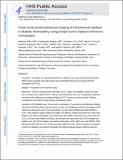| dc.contributor.author | Badaro, Emmerson | |
| dc.contributor.author | Kraus, Martin F. | |
| dc.contributor.author | Baumal, Caroline R. | |
| dc.contributor.author | Witkin, Andre J. | |
| dc.contributor.author | Hornegger, Joachim | |
| dc.contributor.author | Duker, Jay S. | |
| dc.contributor.author | Waheed, Nadia K. | |
| dc.contributor.author | Adhi, Mehreen | |
| dc.contributor.author | Liu, Jonathan Jaoshin | |
| dc.contributor.author | Fujimoto, James G | |
| dc.date.accessioned | 2017-08-02T15:21:59Z | |
| dc.date.available | 2017-08-02T15:21:59Z | |
| dc.date.issued | 2015-11 | |
| dc.date.submitted | 2015-10 | |
| dc.identifier.issn | 0002-9394 | |
| dc.identifier.uri | http://hdl.handle.net/1721.1/110908 | |
| dc.description.abstract | Purpose
To analyze the vitreoretinal interface in diabetic eyes using 3-dimensional wide-field volumes acquired using high-speed, long-wavelength swept-source optical coherence tomography (SSOCT).
Design
Prospective cross-sectional study.
Methods
Fifty-six diabetic patients (88 eyes) and 11 healthy nondiabetic controls (22 eyes) were recruited. Up to 8 SSOCT volumes were acquired for each eye. A registration algorithm removed motion artifacts and merged multiple SSOCT volumes to improve signal. Vitreous visualization was enhanced using vitreous windowing method.
Results
Of 88 diabetic eyes, 20 eyes had no retinopathy, 21 eyes had nonproliferative diabetic retinopathy (NPDR) without macular edema, 20 eyes had proliferative diabetic retinopathy (PDR) without macular edema, and 27 eyes had diabetic macular edema (DME) with either NPDR or PDR. Thick posterior hyaloid relative to healthy nondiabetic controls was observed in 0 of 20 (0%) diabetic eyes without retinopathy, 4 of 21 (19%) eyes with NPDR, 11 of 20 (55%) eyes with PDR, and 11 of 27 (41%) eyes with DME (P = .0001). Vitreoschisis was observed in 6 of 22 (27%) healthy nondiabetic eyes, 9 of 20 (45%) diabetic eyes without retinopathy, 10 of 21 (48%) eyes with NPDR, 13 of 20 (65%) eyes with PDR, and 17 of 27 (63%) eyes with DME (P = .007). While no healthy nondiabetic controls and diabetic eyes without retinopathy had adhesions/pegs between detached posterior hyaloid and retina, 1 of 21 (4%), 11 of 20 (55%), and 11 of 27 (41%) eyes with NPDR, PDR, and DME, respectively, demonstrated this feature (P = .0001).
Conclusion
SSOCT with motion-correction and vitreous windowing provides wide-field 3-dimensional information of vitreoretinal interface in diabetic eyes. This may be useful in assessing progression of retinopathy, planning diabetic vitreous surgery, and predicting treatment outcomes. | en_US |
| dc.description.sponsorship | National Institutes of Health (U.S.) (R01-EY011289-28) | en_US |
| dc.description.sponsorship | National Institutes of Health (U.S.) (R01-EY013178-12) | en_US |
| dc.description.sponsorship | National Institutes of Health (U.S.) (R01-CA075289-16) | en_US |
| dc.description.sponsorship | United States. Air Force Office of Scientific Research (FA9550-10-1-0551) | en_US |
| dc.description.sponsorship | United States. Air Force Office of Scientific Research (FA9550-12-1-0499) | en_US |
| dc.language.iso | en_US | |
| dc.publisher | Elsevier | en_US |
| dc.relation.isversionof | http://dx.doi.org/10.1016/j.ajo.2015.10.025 | en_US |
| dc.rights | Creative Commons Attribution-NonCommercial-NoDerivs License | en_US |
| dc.rights.uri | http://creativecommons.org/licenses/by-nc-nd/4.0/ | en_US |
| dc.source | PMC | en_US |
| dc.title | Three-Dimensional Enhanced Imaging of Vitreoretinal Interface in Diabetic Retinopathy Using Swept-Source Optical Coherence Tomography | en_US |
| dc.type | Article | en_US |
| dc.identifier.citation | Adhi, Mehreen; Badaro, Emmerson; Liu, Jonathan J. et al. “Three-Dimensional Enhanced Imaging of Vitreoretinal Interface in Diabetic Retinopathy Using Swept-Source Optical Coherence Tomography.” American Journal of Ophthalmology 162 (February 2016): 140–149 © 2016 Elsevier Inc | en_US |
| dc.contributor.department | Massachusetts Institute of Technology. Department of Electrical Engineering and Computer Science | en_US |
| dc.contributor.department | Massachusetts Institute of Technology. Research Laboratory of Electronics | en_US |
| dc.contributor.mitauthor | Adhi, Mehreen | |
| dc.contributor.mitauthor | Liu, Jonathan Jaoshin | |
| dc.contributor.mitauthor | Fujimoto, James G | |
| dc.relation.journal | American Journal of Ophthalmology | en_US |
| dc.eprint.version | Author's final manuscript | en_US |
| dc.type.uri | http://purl.org/eprint/type/JournalArticle | en_US |
| eprint.status | http://purl.org/eprint/status/PeerReviewed | en_US |
| dspace.orderedauthors | Adhi, Mehreen; Badaro, Emmerson; Liu, Jonathan J.; Kraus, Martin F.; Baumal, Caroline R.; Witkin, Andre J.; Hornegger, Joachim; Fujimoto, James G.; Duker, Jay S.; Waheed, Nadia K. | en_US |
| dspace.embargo.terms | N | en_US |
| dc.identifier.orcid | https://orcid.org/0000-0002-0828-4357 | |
| mit.license | PUBLISHER_CC | en_US |
| mit.metadata.status | Complete | |
